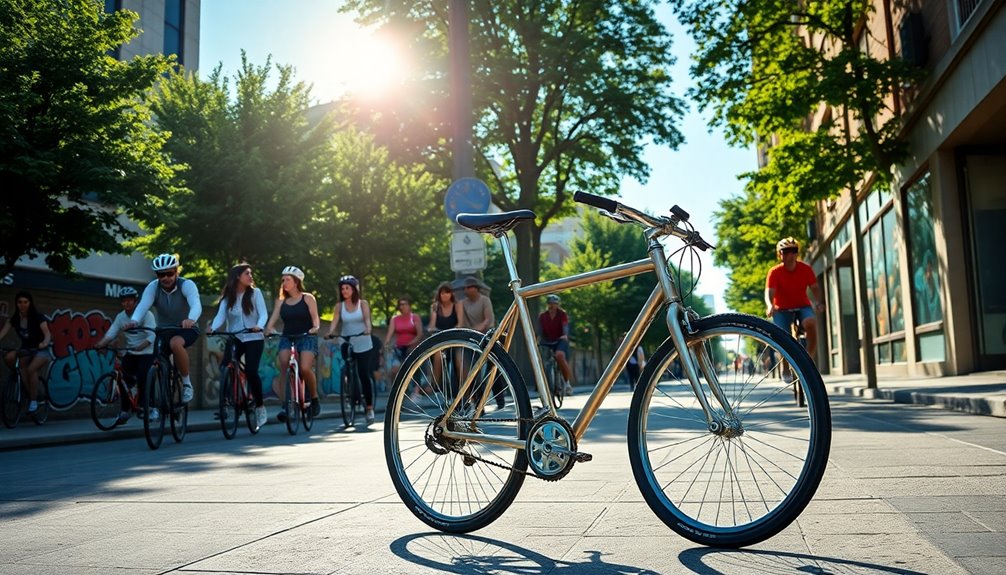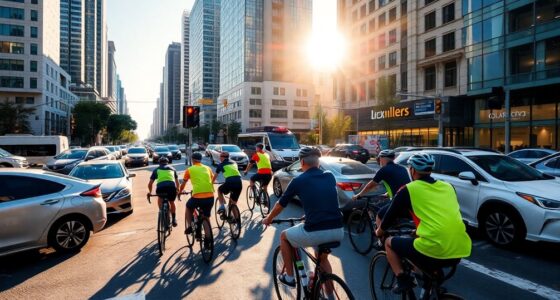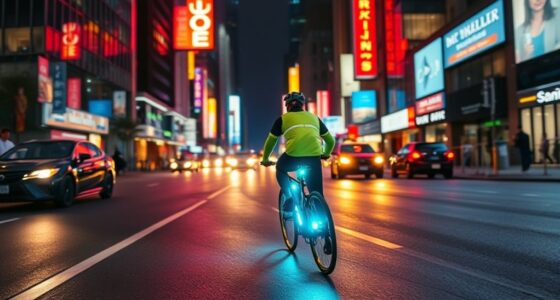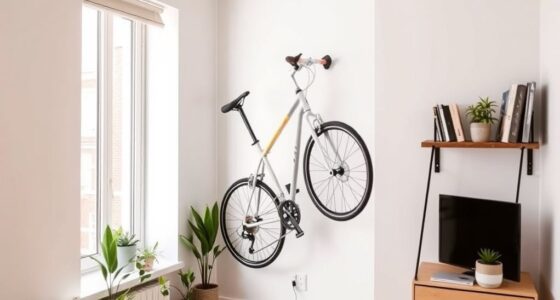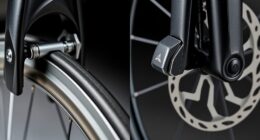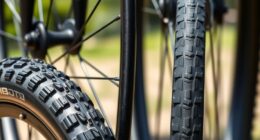To choose the perfect city bike for urban cycling, assess your riding needs like commute frequency, terrain, and comfort preferences. Look for key features such as an upright position, cushioned saddle, and practical accessories like mudguards and lights. Evaluate durability by checking frame material and maintenance options. Consider innovative technologies like e-bikes for added convenience. Finally, keep your budget in mind, as options range widely. Keep exploring to find the best fit for your urban adventures!
Key Takeaways
- Assess your riding frequency and terrain to determine the best gearing and bike style for your urban cycling needs.
- Look for features like an upright riding position, cushioned saddle, and flat handlebars for enhanced comfort during city rides.
- Choose durable materials, such as steel frames and puncture-resistant tires, to ensure longevity and low maintenance in urban environments.
- Consider practical accessories like mudguards, integrated lights, and racks to improve functionality and safety while commuting.
- Set a budget that aligns with your requirements, ranging from under $500 for basic models to over $2,000 for high-end options.
Understanding Your Riding Needs
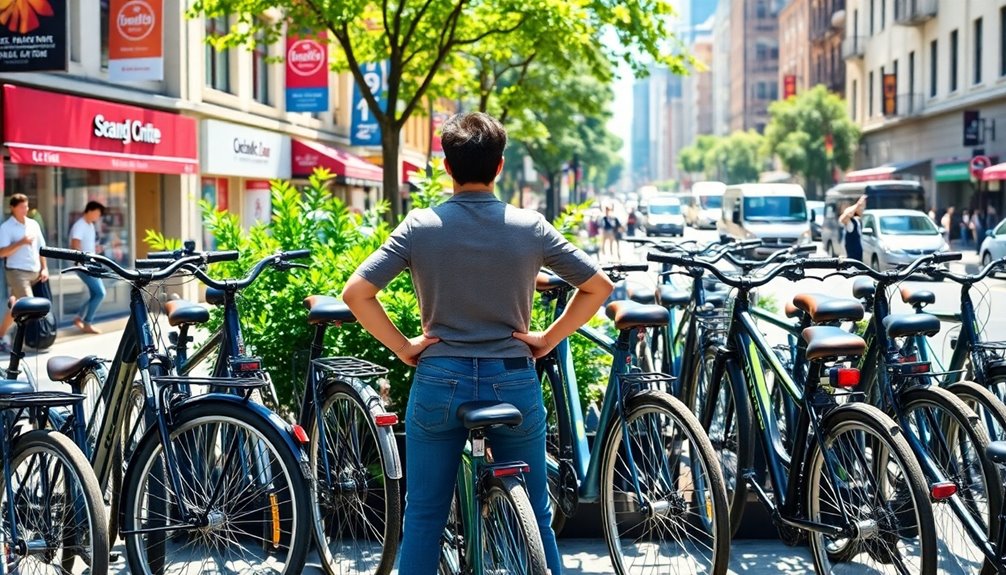
When you begin choosing a city bike, it's essential to understand your riding needs, as this will guide your decision.
Think about how often you'll ride. Are you commuting daily, enjoying occasional leisure trips, or aiming to meet fitness goals? Your riding frequency shapes the type of bike you should consider.
Next, assess the terrain you'll encounter. If you're navigating flat roads, you can opt for simpler gearing, but hilly areas may require more options.
Also, consider your lifestyle. Do you prioritize comfort for relaxed rides, or speed for aggressive cycling?
Lastly, reflect on your fitness level. Beginners may prefer bikes with upright positions, while advanced cyclists might seek performance features.
Each choice impacts your overall riding experience.
Key Features to Look For

As you dive into selecting the perfect city bike, focusing on key features can significantly enhance your riding experience.
Look for an upright riding position that ensures comfort and visibility. A larger, cushioned saddle will make long rides more enjoyable, while flat handlebars promote a relaxed posture.
Consider bikes with suspension systems to absorb bumps on uneven roads, and ergonomic grips for added comfort.
For performance, choose models with a wide gearing range and all-terrain tires for better grip. Reliable braking systems, like disc brakes, are crucial for safety.
Don't forget practical accessories like mudguards, integrated lights, and luggage racks to make your urban cycling experience seamless and convenient.
Evaluating Durability and Maintenance
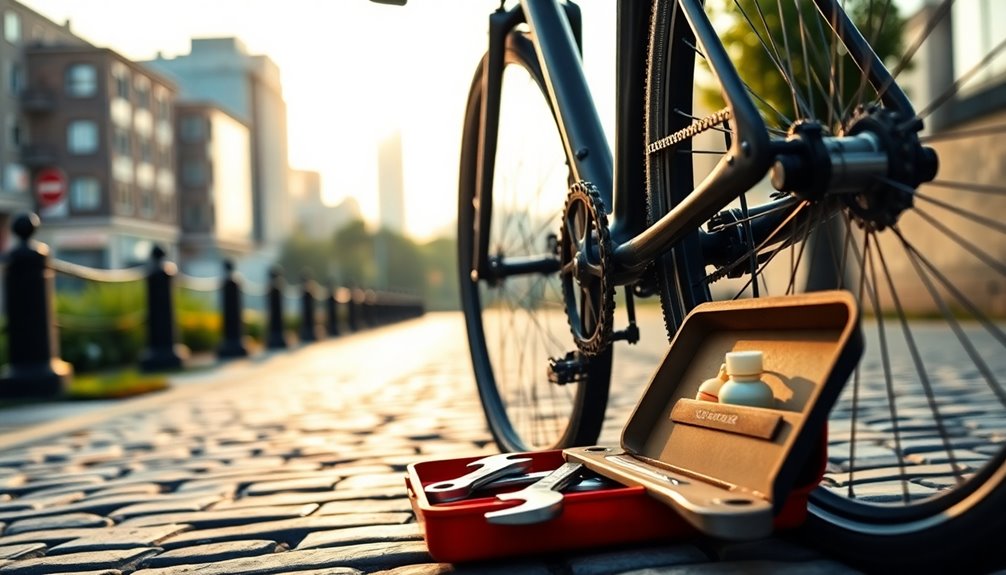
Evaluating durability and maintenance is essential to ensure your city bike withstands the demands of urban cycling.
Start by examining the frame material; steel is often preferred for its strength and vibration absorption. Check for corrosion resistance to prevent rust, especially in wet conditions.
The bike's components are equally important; opt for wide-ranging gearing systems and durable disc brakes for varied terrains. Puncture-resistant tires minimize maintenance, while regular cleaning and lubrication of the chain and cassette extend their lifespan.
Establish a maintenance routine with regular inspections and timely replacements to catch wear before it escalates. Additionally, investing in quality components can significantly enhance handling and aesthetics, improving your overall riding experience.
Investing in quality components may seem costly initially, but it pays off in long-term durability and performance.
Exploring Innovative Technologies

Innovative technologies are transforming urban cycling, making it more accessible and enjoyable for riders. Smart locking systems, like those from Lyft Urban Solutions, enhance bike-sharing services by providing secure, efficient docking points that even charge e-bikes and e-scooters.
With QR code scanning, you can rent bikes quickly, while geofencing technology helps manage overflow. Real-time mapping features enable you to find available bikes and plan your routes effectively.
Meanwhile, connected bike technologies offer safety with geolocation and theft alerts, ensuring your ride is secure. E-bikes are also becoming favorites, providing pedal-assist for longer journeys while reducing urban congestion. Additionally, innovations in home security systems are also aimed at improving urban living by ensuring safe environments for cyclists.
These innovations not only improve your experience but also promote sustainable mobility in the city.
Budget Considerations and Options
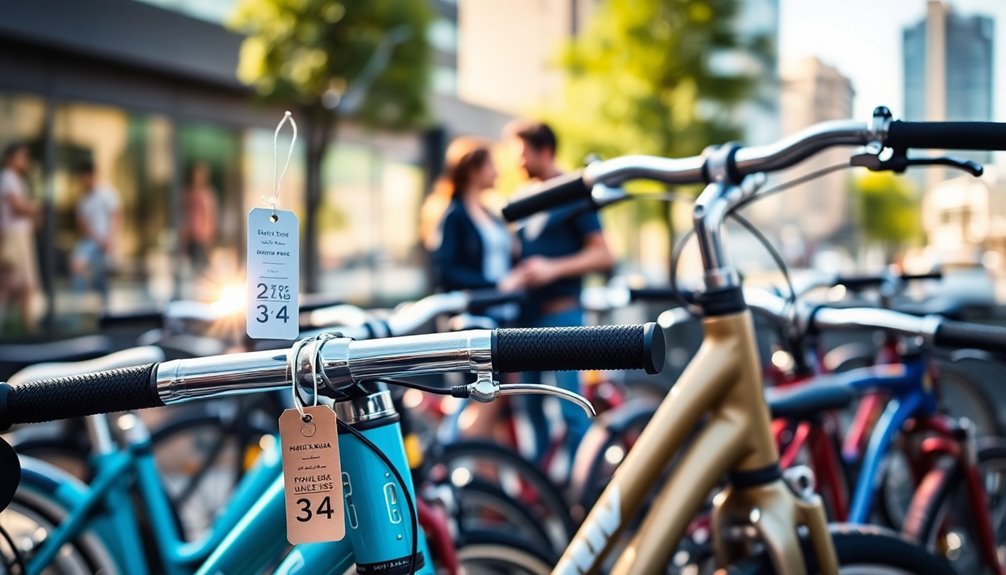
With the rise of innovative technologies in urban cycling, it's important to consider the budget when selecting a bike that fits your needs.
Commuter bikes generally range from under $500 for budget-friendly options to over $2,000 for high-end models. Non-electric bikes typically cost between $500 and $800, offering basic functionality, while electric bikes start around $1,000.
You'll find great value in options like the Electra Loft 7D or the Co-op Cycles CTY 1.1. Remember, spending more often means better components and features, like fenders and lights.
For short commutes, a budget bike might suffice, but for longer rides or varied terrain, investing a bit more will enhance your experience and ensure you enjoy every ride through the city.
Frequently Asked Questions
What Is the Best Bike Size for My Height?
Finding the right bike size is like slipping into a perfectly tailored suit; it makes all the difference.
For your height, you'll want to measure both your height and inseam. Generally, if you're between 140-155 cm, go for XXS; 155-165 cm, pick S; and 165-175 cm, M might be your best bet.
Remember, a little standover clearance ensures comfort and safety.
How Do I Properly Maintain My City Bike?
To properly maintain your city bike, start with daily checks like tire pressure, brake function, and wheel security.
Weekly, lubricate the chain and inspect cables.
Monthly, clean your bike and tighten bolts.
Don't forget seasonal upkeep—adjust bearings and replace worn brake pads.
Regular maintenance keeps your bike in top shape, ensuring a smooth ride and extending its lifespan.
Make these checks a habit, and you'll enjoy hassle-free cycling.
Can I Customize My City Bike With Accessories?
You'll be surprised to find just how many ways you can customize your city bike with accessories!
From comfort-enhancing saddles to safety features like lights and mirrors, there's something for everyone. You can add baskets for cargo or switch out grips for a better feel.
Personalizing your ride not only makes it unique but also improves its functionality.
What Safety Gear Should I Consider Besides a Helmet?
Besides a helmet, you should consider several essential safety gear options.
Reflective clothing boosts your visibility, especially in low light. Equip your bike with front and rear lights, and think about lighted wheels for extra safety at night.
Don't forget gloves for grip and comfort, knee pads for protection against falls, and mirrors to keep an eye on traffic behind you.
These items work together to enhance your overall safety while cycling.
How Do I Choose a Bike Lock for Urban Areas?
Choosing a bike lock can feel like picking a Netflix show—there's just too much out there!
You need to assess your security needs first. If theft's rampant, go for a U-lock; it's tough but heavy. For flexibility, try a chain or folding lock.
Think about how long you'll be locking up your bike and check the lock's material and brand reputation.
Don't forget to read reviews and consider your budget!
Conclusion
Choosing the perfect city bike is like finding the right dance partner; you want something that moves seamlessly with you. By understanding your riding needs and focusing on key features, durability, and modern technologies, you'll make an informed decision. Don't forget to keep your budget in mind, as there's a great bike for every wallet. With the right ride, you'll glide through the city streets, turning every commute into an enjoyable journey.
